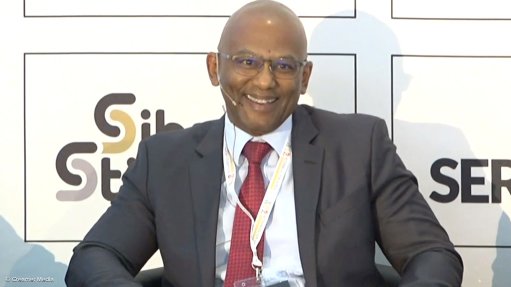
DMPR mineral and petroleum regulation deputy director-general Tseliso Maqubela
Work on South Africa’s new mining cadastral system is “well under way”, Department of Mineral and Petroleum Resources (DMPR) mineral and petroleum regulation deputy director-general Tseliso Maqubela said on May 27, speaking during the first day of the Junior Indaba 2025.
“We are on track to deliver a robust, transparent, efficient cadastral system. We are resolving challenges as they emerge.”
Maqubela explained that the system would be rolled out over time in different regions, rather than a single nationwide launch.
This would begin in the Western Cape, with this targeted to start in June as previously committed.
He explained that, when this is live, the previous South African Mineral Resources Administration System, or Samrad, online system would be switched off for this region, and applications would have to occur on the new system.
Currently, data migration and validation is under way, particularly for the starting region.
Maqubela said the Western Cape was chosen because it is a manageable mining jurisdiction, with a large number of operating mines, which would allow for the efficacy of the system to be tested. It also does not have an appreciable backlog, and there are also a limited number of appeals that are outstanding.
The Eastern Cape would be the second region, with the rest of the provinces to follow thereafter.
Maqubela said the DMPR was aware that some regions would be more complex to manage.
He also mentioned a key feature in the new system as the introduction of a grid, which would be used to deal with the overlap of polygons.
Maqubela called for feedback once the system is launched, to ensure necessary adjustments can be implemented.
LEGISLATIVE AND POLICY EFFORTS
Meanwhile, in a panel discussion, 'Creating an enabling environment for junior mining and exploration in South Africa', speakers pointed out that the country’s Critical Minerals and Metals Strategy and the Mineral Resources Development Bill (MRDB) of 2025 present a good “starting point” for supporting the country’s junior mining industry.
However, there are several areas that require further consideration, to ensure junior miners can capitalise fully on the opportunities provided, and to address the challenges that they face.
Cabinet earlier this month approved of the strategy and also approved publication of the MRDB for public comment.
DMPR director-general Jacob Mbele informed that the strategy is expected to be made public by the end of the week. As part of the approval by Cabinet, several recommendations were identified, and the internal work to finalise this is taking longer than expected, he explained.
Mbele emphasised that initiatives like this and the MRDB aim to improve the environment for junior miners, by providing policy certainty and clarity, and aiming to deal with the issues that they have raised with the department.
Legal, environmental and analytics firm NSDV director Lili Nupen, however, identified some points of contention with the MRDB, including the manner in which artisanal and small-scale miners will be granted rights being unclear, requiring clarity.
She also said there was a gap in the Bill in terms of what assistance would be provided in the junior space and called for the next iteration of the Bill to focus on aspects such as incentives and exemptions for junior miners.
Nupen acknowledged that while mining is a long-term game, and the legislation aims to be forward looking, international attention is currently focused on South Africa, and this presents an opportunity to use its legalisation to promote exploration, encourage investment and create an enabling environment for juniors.
She called for those in the space to make their views heard, so that the next version of the Bill accounted for their needs and encouraged exploration.
Minerals Council South Africa CEO Mzila Mthenjane called for updates to the Bill to include specific references to juniors, with a clear delineation of what the threshold for this is.
Mbele pointed out that the Bill was out for public comment, and that the department welcomed all engagement from all stakeholders. ![]()